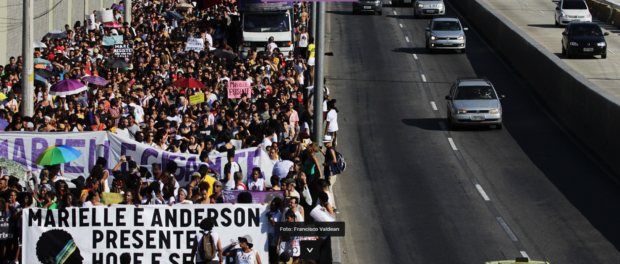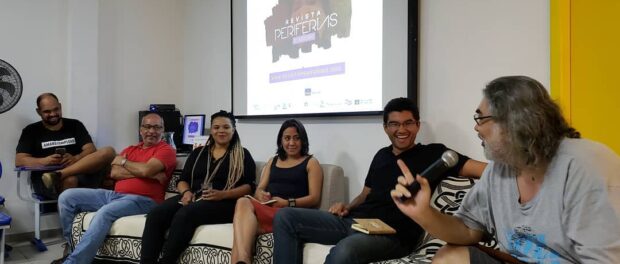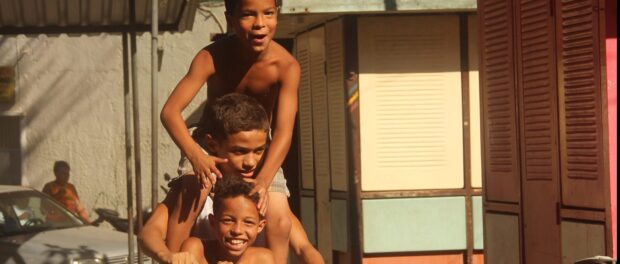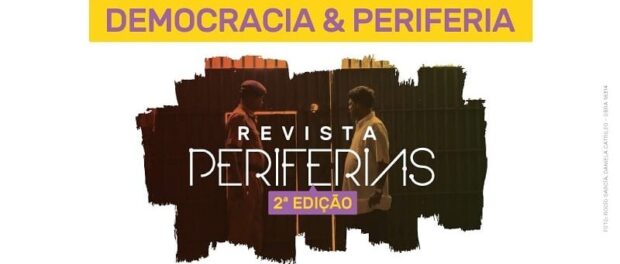
Published by the Maria and João Aleixo Institute (IMJA), a knowledge production institute that aims to break with the formalism and hierarchy of traditional academic institutions, Peripheries Journal is a bi-annual publication guided by the “Paradigm of Potency” of peripheries around the world. This paradigm was the topic of the journal’s first edition, published in May. The topic of the second edition, “Democracy and the Periphery,” comes at a time of profound challenges for Brazilian democracy while also resonating around the world.
In addition to contributions from Rio de Janeiro, this edition includes articles from Belém do Pará (in the North of Brazil), as well as India, Pakistan, Ireland, Turkey, France, Chile, Palestine, Spain, and Argentina. This diversity is a testament to the salience of the collective struggle of peripheries. “It’s quite audacious for an organization from Maré [favela] to bring together a Scottish philosopher and a trans woman from Maré to co-author an article,” Jailson de Souza e Silva, founder of the Favelas Observatory and director of IMJA, playfully remarked in reference to the article “Democratizing the Body and Politics—Transexual and Peripheral Perspectives on Democracy and Dictatorships.” Yet more, the journal is published in four languages: Portuguese, English, Spanish, and French. According to Silva, the next frontier is Arabic, to break past publication solely in Western languages.
In this sense, the institute is working towards forming an International Network of Peripheries, aiming to produce concepts, methodologies, content, and public policy proposals rooted in peripheries around the world, to share practices and methods and develop joint actions and projects. One facet of the network’s development is the creation of the International University of Peripheries (UNIPERIFERIAS).
Silva posits the journal as a form of political and aesthetic contestation. “It’s a new way of viewing peripheries and favelas, seeing these territories not only through the lens of what’s characterized as ‘absent’ or ‘lacking’—which is the traditional approach through which mainstream media and the dominant classes engage with these spaces—but rather based on their assets: their achievements, inventiveness, beauty, and creativity. [But it also offers] the possibility of experimenting with different languages, of knowing what is going on in peripheries around the world to which we don’t have access.”
In addition to Jailson de Souza e Silva and Eduardo Alves (also from IMJA), the discussion at the launch event on December 5 in Complexo da Maré featured Priscila Rodrigues from the Favelas Observatory and Maryuri Grisales, editor of the journal Conectas SUR, and was mediated by Henrique Silveira from Casa Fluminense. “The greatest contribution that you’re making is amplifying the voices of civil society actors—advancing this ‘Paradigm of Potency’ and contesting the narrative of what the periphery is. We’re questioning the role of the center and want to disrupt it, such to reposition the periphery in a different way. Inventiveness, creativity, and daily struggles are very powerful words,” said Grisales. Silveira elaborated: “Speaking of democracy in the periphery, we must constantly ensure that the inventiveness originating from the periphery is recognized, without losing sight of the issue of racism.”

Along the same lines, Rodrigues said that it is necessary to think about democracy from her position as a black woman from the periphery. “Peripheries are not just places—they are peripheral bodies in the city. I have thought a lot about democracy as a verb: democratize. Democratizing spaces, communication channels, conversations. Democracy is only realized when we are debating, building, participating.” An audience member agreed: “When we come together to pump water from one street to the next, or when we clear the ground to create a playing field… Democracy, as a verb, is present in our childhoods—it’s not necessary to invent something new.”
In the contribution to the journal by Catalytic Communities,* we discussed the ways by which peripheries work to strengthen and realize a democracy that, like public services, reaches residents imperfectly and selectively. Thus, in the face of democracy’s selectivity, we chose to highlight a series of initiatives that demonstrate how, in practice, individuals and groups in the periphery are fighting for increased representation, greater respect for human and constitutional rights (not only the right to life, but also freedom of movement and rights to culture and education), and more participatory forms of government. In Silva’s words, we need “a democracy that respects the use of our bodies and places public institutions at our disposal.”

“Even the Left sees the periphery as a manifestation of social inequality. Where is the city to be found—in favelas or in Barra da Tijuca [a wealthy, segregated neighborhood of gated condominiums]? Barra has more of the urbs—the government installed more facilities there—but the city is not more present there. When we think about the polis, about dimensions of sociability and inventiveness, the city exists in its favelas. There is much more vitality there,” Silva stated. “In physical geography, the city is singular. In human geography, it’s full of contradictions. There aren’t two cities—there are myriad. Thinking across these different scales enables us to place ourselves at the forefront—to place the periphery at the center,” Alves concluded.
Check out the second edition of Peripheries here and the article titled “The Role of Peripheries in Democracy” by Catalytic Communities here. Peripheries is accepting submissions on the topic of “Alternative Experiences of the Peripheries” for its third edition through March 2019.
*RioOnWatch is a project of the NGO Catalytic Communities.

